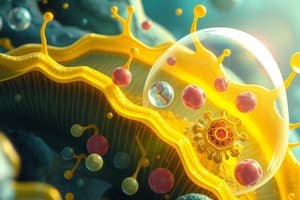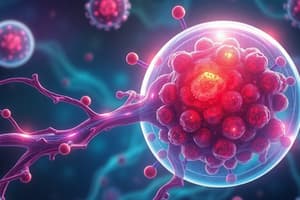Podcast
Questions and Answers
What function does the plasma membrane perform aside from separating a cell from its external environment?
What function does the plasma membrane perform aside from separating a cell from its external environment?
Regulates passage of molecules into and out of the cell
What is the role of the nucleus in a cell?
What is the role of the nucleus in a cell?
Control cells metabolic activities and replication
What does the cell membrane regulate?
What does the cell membrane regulate?
Transport of substances into and out of the cell
What are mitochondria known for?
What are mitochondria known for?
What is the primary function of ribosomes?
What is the primary function of ribosomes?
What is the function of peroxisomes?
What is the function of peroxisomes?
What do lysosomes contain?
What do lysosomes contain?
What are cilia?
What are cilia?
What is the role of centrioles?
What is the role of centrioles?
What is active transport?
What is active transport?
What is filtration?
What is filtration?
What is osmosis?
What is osmosis?
What does diffusion refer to?
What does diffusion refer to?
What is dysplasia?
What is dysplasia?
What defines a benign tumor?
What defines a benign tumor?
What is a neoplasm?
What is a neoplasm?
What is neoplasia?
What is neoplasia?
What is atrophy?
What is atrophy?
What is hyperplasia?
What is hyperplasia?
What is hypertrophy?
What is hypertrophy?
What type of tumor is papilloma?
What type of tumor is papilloma?
What are lysosomes commonly referred to as?
What are lysosomes commonly referred to as?
What is the resting phase in the process of mitosis called?
What is the resting phase in the process of mitosis called?
What is the term for DNA and protein material in a loose and diffuse state?
What is the term for DNA and protein material in a loose and diffuse state?
What is the term used for the increase in cell number?
What is the term used for the increase in cell number?
Which structure controls the activities of the cell and facilitates cell division?
Which structure controls the activities of the cell and facilitates cell division?
What differentiates rough endoplasmic reticulum from smooth endoplasmic reticulum?
What differentiates rough endoplasmic reticulum from smooth endoplasmic reticulum?
Where does most of the cell's energy come from?
Where does most of the cell's energy come from?
What is an example of passive transport of materials through the cell membrane?
What is an example of passive transport of materials through the cell membrane?
What is the change to the size, shape, and organization of cells as a result of a stimulus called?
What is the change to the size, shape, and organization of cells as a result of a stimulus called?
What is protoplasm?
What is protoplasm?
During which phase do the chromosomes migrate to the opposite poles of the cell?
During which phase do the chromosomes migrate to the opposite poles of the cell?
What does the word root 'cyto' mean?
What does the word root 'cyto' mean?
Which structure regulates the passage or transport of certain molecules into and out of the cell?
Which structure regulates the passage or transport of certain molecules into and out of the cell?
What is cell eating called?
What is cell eating called?
What unit of measurement is used to measure the size of cells and their components?
What unit of measurement is used to measure the size of cells and their components?
What are ribosomes composed of?
What are ribosomes composed of?
Which structures store the hereditary material DNA?
Which structures store the hereditary material DNA?
What is the background for all chemical reactions that take place in a cell?
What is the background for all chemical reactions that take place in a cell?
What describes the movement of water molecules across a semipermeable membrane from a solution of higher concentration to a solution of lower concentration?
What describes the movement of water molecules across a semipermeable membrane from a solution of higher concentration to a solution of lower concentration?
What does the suffix -plasm mean?
What does the suffix -plasm mean?
How would you best describe the cell membrane?
How would you best describe the cell membrane?
How many chromosomes are in a human cell?
How many chromosomes are in a human cell?
During which phase of mitosis does the nuclear membrane start to dissolve?
During which phase of mitosis does the nuclear membrane start to dissolve?
Which of the following is not a cause of cell necrosis?
Which of the following is not a cause of cell necrosis?
What term describes the state in which molecules are evenly distributed in the available space?
What term describes the state in which molecules are evenly distributed in the available space?
What is osmosis?
What is osmosis?
What chemical compound is required for active transport?
What chemical compound is required for active transport?
What is the key difference between phagocytosis and pinocytosis?
What is the key difference between phagocytosis and pinocytosis?
Which statement is true regarding specialization among cells?
Which statement is true regarding specialization among cells?
What type of cancer occurs in bones, tissues, muscles, and fat?
What type of cancer occurs in bones, tissues, muscles, and fat?
Flashcards are hidden until you start studying
Study Notes
Cell Structure and Function
- Plasma membrane regulates molecule passage and separates internal and external environments.
- The nucleus controls cell metabolism and replication.
- Cell membrane also serves as a barrier, facilitating substance transport.
Organelles and Their Functions
- Mitochondria are responsible for cellular respiration and producing energy.
- Ribosomes are the sites for protein synthesis.
- Peroxisomes house enzymes that assist in fat digestion.
- Lysosomes contain enzymes for protein digestion, often referred to as "suicide bags."
Cellular Movement and Transport Mechanisms
- Active transport moves particles from lower to higher concentration against the gradient utilizing energy (ATP).
- Osmosis describes the movement of solvent across a membrane from high solute concentration to low.
- Diffusion is the process where particles spread evenly in a medium.
- Filtration involves the movement of solutes and water across a membrane due to mechanical force.
Cell Growth and Changes
- Dysplasia represents changes in cell size, shape, and organization due to stimuli.
- Benign tumors are localized clusters of abnormal cells.
- Neoplasm refers to abnormal cell division patterns.
- Neoplasia indicates uncontrolled growth patterns with altered cell structures.
- Atrophy describes cell size reduction due to aging or disease, while hypertrophy denotes an increase in cell size from overload.
- Hyperplasia is characterized by an increase in cell number, often linked to hormonal influences.
Tumors
- Papilloma is a tumor type arising from epithelial tissue.
- Sarcoma refers to cancer occurring in bones, muscles, and connective tissues.
Cell Activity and Life Cycle
- Interphase is the resting phase in the mitosis process.
- Chromatin consists of loose DNA and protein material.
- Rough endoplasmic reticulum is identified by the presence of ribosomes, differentiating it from smooth endoplasmic reticulum.
Membrane Dynamics
- The cell membrane is selectively semipermeable, regulating the transport of essential molecules.
- Phagocytosis (cell eating) involves engulfing solid particles, while pinocytosis (cell drinking) pertains to engulfing liquids.
Measurement and Composition
- The micron (micrometer) is the unit used to measure cell sizes and components.
- Ribosomes, composed of RNA and protein, synthesize proteins.
- Chromosomes store DNA, ensuring genetic information is passed to future generations.
- Cytoplasm is the medium where cellular reactions occur.
Cell Division Insights
- Telophase is when chromosomes migrate to cell poles during mitosis.
- Mitosis begins with prophase, where the nuclear membrane starts dissolving.
- Human cells typically contain 46 chromosomes.
Additional Definitions and Concepts
- The suffix "-plasm" refers to growth.
- Equilibrium denotes a state where molecules are evenly spaced within a given area.
- Active transport requires ATP (Adenosine triphosphate) for energy.
- Understanding the difference between phagocytosis and pinocytosis is crucial for recognizing how cells obtain resources and nutrients.
- Specialized cells may lose their ability to reproduce, highlighting their specific functions within tissues.
Studying That Suits You
Use AI to generate personalized quizzes and flashcards to suit your learning preferences.




